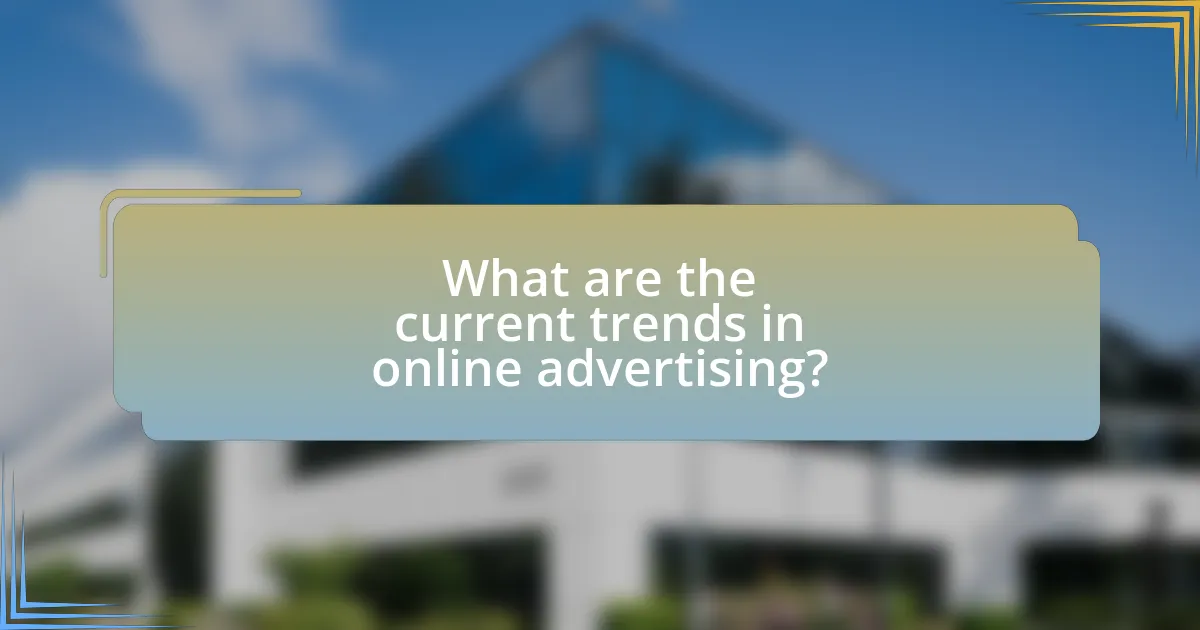The article focuses on the future of online advertising, highlighting current trends and predictions that shape the industry. Key trends include the increased use of artificial intelligence for personalized ad targeting, a shift towards video content, and a growing emphasis on privacy and data protection. Consumer behavior is driving demand for personalized advertising, while demographic shifts and technological advancements are influencing advertising effectiveness. Emerging platforms such as TikTok and connected TV are reshaping strategies, and privacy regulations are prompting changes in data collection practices. The article also discusses how businesses can adapt to these changes by leveraging data analytics and adopting best practices in online advertising.

What are the current trends in online advertising?
Current trends in online advertising include increased use of artificial intelligence for personalized ad targeting, a shift towards video content, and a growing emphasis on privacy and data protection. Artificial intelligence enables advertisers to analyze consumer behavior and preferences, leading to more effective ad placements. According to a report by eMarketer, video ad spending is projected to reach $61 billion by 2024, highlighting the rising popularity of video as a medium. Additionally, regulations like GDPR and CCPA are pushing companies to adopt transparent data practices, influencing how ads are delivered and tracked.
How is consumer behavior influencing online advertising trends?
Consumer behavior is significantly influencing online advertising trends by driving the demand for personalized and targeted advertising strategies. As consumers increasingly expect tailored experiences, advertisers are leveraging data analytics and machine learning to create ads that resonate with individual preferences and behaviors. For instance, a study by eMarketer found that 72% of consumers only engage with personalized messaging, highlighting the effectiveness of targeted advertising. This shift towards personalization is prompting brands to invest in advanced technologies that analyze consumer data, thereby enhancing engagement and conversion rates.
What changes in consumer preferences are shaping advertising strategies?
Changes in consumer preferences that are shaping advertising strategies include a growing demand for personalized content, increased emphasis on sustainability, and a shift towards digital and mobile platforms. Consumers now expect brands to deliver tailored experiences based on their individual preferences and behaviors, leading advertisers to utilize data analytics and AI for targeted campaigns. Additionally, the rising awareness of environmental issues has prompted consumers to favor brands that demonstrate social responsibility, influencing advertisers to highlight sustainable practices in their messaging. Furthermore, the proliferation of smartphones and social media has shifted consumer engagement towards digital channels, compelling advertisers to adapt their strategies to focus on mobile-friendly content and interactive formats. These trends are supported by research indicating that 80% of consumers are more likely to make a purchase when brands offer personalized experiences, and 66% of consumers are willing to pay more for sustainable products.
How do demographic shifts impact online advertising effectiveness?
Demographic shifts significantly impact online advertising effectiveness by altering target audience characteristics and preferences. As populations age or diversify, advertisers must adapt their strategies to resonate with new consumer behaviors and values. For instance, a report by the Pew Research Center indicates that younger generations, such as Millennials and Gen Z, prefer authentic and relatable content, which influences the types of advertisements that perform well. Additionally, changes in income levels and education among different demographic groups can affect purchasing power and brand loyalty, necessitating tailored messaging and platforms for effective engagement.
What technological advancements are driving online advertising?
Artificial intelligence (AI) and machine learning are the primary technological advancements driving online advertising. These technologies enable advertisers to analyze vast amounts of data to optimize targeting and personalize content, resulting in higher engagement rates. For instance, AI algorithms can predict consumer behavior based on past interactions, allowing for more effective ad placements. According to a report by eMarketer, digital ad spending in the U.S. is projected to reach $191 billion in 2021, largely due to the efficiencies gained through AI-driven strategies. Additionally, advancements in programmatic advertising automate the buying and selling of ad space, further enhancing the efficiency of online advertising campaigns.
How is artificial intelligence transforming ad targeting?
Artificial intelligence is transforming ad targeting by enabling more precise audience segmentation and personalized content delivery. AI algorithms analyze vast amounts of data, including user behavior, preferences, and demographics, to identify patterns and predict which ads will resonate with specific audiences. For instance, a study by McKinsey & Company found that companies using AI for marketing can increase their ROI by 15-20% through improved targeting strategies. This data-driven approach allows advertisers to optimize their campaigns in real-time, ensuring that the right message reaches the right person at the right time, ultimately enhancing engagement and conversion rates.
What role does data analytics play in optimizing online campaigns?
Data analytics plays a crucial role in optimizing online campaigns by enabling marketers to make data-driven decisions that enhance performance. By analyzing user behavior, engagement metrics, and conversion rates, marketers can identify which strategies are effective and which need adjustment. For instance, a study by McKinsey & Company found that companies leveraging data analytics in their marketing efforts can achieve a 15-20% increase in ROI. This demonstrates that data analytics not only informs targeting and personalization but also helps in reallocating budgets to the most effective channels, ultimately leading to improved campaign outcomes.
What are the emerging platforms for online advertising?
Emerging platforms for online advertising include TikTok, programmatic audio advertising, and connected TV (CTV). TikTok has rapidly gained popularity, with over 1 billion monthly active users, making it a key player for brands targeting younger demographics. Programmatic audio advertising is on the rise, driven by the increasing consumption of podcasts and streaming services, which are projected to reach $3.5 billion in ad revenue by 2025. Connected TV (CTV) is also expanding, as more households adopt smart TVs, leading to a projected increase in CTV ad spending to $23 billion by 2024. These platforms reflect the evolving landscape of digital marketing, emphasizing the need for advertisers to adapt to new consumer behaviors and preferences.
How are social media platforms evolving for advertisers?
Social media platforms are evolving for advertisers by integrating advanced targeting capabilities and enhancing user engagement features. These platforms now utilize artificial intelligence and machine learning algorithms to analyze user behavior, allowing advertisers to reach specific demographics with greater precision. For instance, Facebook’s advertising tools enable advertisers to create highly customized ad campaigns based on user interests, location, and online activity, resulting in improved conversion rates. Additionally, platforms like Instagram and TikTok are increasingly incorporating shoppable posts and interactive content, which facilitate direct purchases and foster deeper connections between brands and consumers. This evolution is supported by data indicating that social media ad spending is projected to reach $200 billion by 2024, reflecting the growing importance of these platforms in advertising strategies.
What impact do new digital channels have on advertising strategies?
New digital channels significantly enhance advertising strategies by enabling targeted, data-driven campaigns that reach specific audiences more effectively. These channels, such as social media platforms, mobile apps, and streaming services, allow advertisers to utilize advanced analytics and consumer behavior insights, leading to personalized messaging. For instance, according to a report by eMarketer, digital ad spending in the U.S. is projected to surpass $200 billion in 2023, reflecting the growing reliance on these channels for effective audience engagement. This shift not only increases the efficiency of ad spend but also improves conversion rates, as brands can tailor their content to meet the preferences and behaviors of their target demographics.

What predictions can be made about the future of online advertising?
The future of online advertising is predicted to be increasingly driven by artificial intelligence and data privacy regulations. AI technologies will enhance targeting and personalization, allowing advertisers to deliver more relevant content to consumers. According to a report by eMarketer, spending on AI-driven advertising is expected to reach $107 billion by 2025, indicating a significant shift towards automated and data-informed strategies. Additionally, as privacy regulations like GDPR and CCPA become more prevalent, advertisers will need to adapt their approaches to comply with these laws, which may lead to a greater emphasis on first-party data collection and transparent practices. This dual focus on AI and privacy will shape the landscape of online advertising in the coming years.
How will privacy regulations affect online advertising practices?
Privacy regulations will significantly restrict online advertising practices by limiting data collection and usage. These regulations, such as the General Data Protection Regulation (GDPR) in Europe and the California Consumer Privacy Act (CCPA), mandate that companies obtain explicit consent from users before collecting personal data. As a result, advertisers will face challenges in targeting specific audiences effectively, leading to a potential decrease in ad personalization and effectiveness. According to a report by the Interactive Advertising Bureau (IAB), compliance with privacy regulations could reduce the effectiveness of targeted advertising by up to 50%, as advertisers may have access to less data for audience segmentation. This shift will compel advertisers to adapt their strategies, focusing more on contextual advertising and first-party data collection methods.
What changes can we expect in data collection and usage?
We can expect significant changes in data collection and usage, primarily driven by evolving privacy regulations and advancements in technology. As governments implement stricter data protection laws, such as the General Data Protection Regulation (GDPR) in Europe and the California Consumer Privacy Act (CCPA) in the United States, companies will need to adopt more transparent data practices. This includes obtaining explicit consent from users before collecting their data and providing clear options for data management. Additionally, the rise of artificial intelligence and machine learning will enhance data analytics capabilities, allowing businesses to derive insights from smaller data sets while respecting user privacy. These trends indicate a shift towards more ethical data usage, emphasizing user control and data minimization.
How might consumer trust influence advertising strategies in the future?
Consumer trust will significantly influence advertising strategies in the future by driving brands to prioritize transparency and authenticity in their messaging. As consumers increasingly demand honesty and ethical practices, companies will adapt their advertising approaches to build and maintain trust. For instance, a 2021 survey by Edelman found that 81% of consumers stated that they must be able to trust the brand to do what is right. This statistic underscores the necessity for brands to incorporate trust-building elements, such as user-generated content and real customer testimonials, into their advertising strategies. Consequently, brands that effectively foster consumer trust are likely to see improved customer loyalty and engagement, ultimately leading to better business outcomes.
What innovations are likely to emerge in online advertising technology?
Innovations likely to emerge in online advertising technology include advanced artificial intelligence for personalized ad targeting, augmented reality for immersive ad experiences, and blockchain for enhanced transparency in ad transactions. Advanced AI algorithms will enable advertisers to analyze consumer behavior more effectively, leading to highly tailored advertising strategies. Augmented reality will allow brands to create interactive experiences that engage users in novel ways, enhancing brand recall and customer interaction. Blockchain technology will provide a secure and transparent framework for ad transactions, reducing fraud and ensuring that advertisers can track the effectiveness of their campaigns accurately. These innovations are supported by ongoing advancements in machine learning, user engagement metrics, and the increasing demand for transparency in digital advertising.
How will augmented reality and virtual reality change advertising experiences?
Augmented reality (AR) and virtual reality (VR) will transform advertising experiences by creating immersive and interactive environments that engage consumers more effectively than traditional media. These technologies allow brands to showcase products in a three-dimensional space, enabling potential customers to visualize and interact with items before making a purchase. For instance, a study by Deloitte found that 40% of consumers are more likely to make a purchase after experiencing AR content, highlighting its effectiveness in driving sales. Additionally, AR and VR can personalize advertising by tailoring experiences to individual preferences, further enhancing consumer engagement and brand loyalty.
What future trends can we anticipate in programmatic advertising?
Future trends in programmatic advertising include increased use of artificial intelligence for better targeting and optimization, a shift towards privacy-centric advertising due to regulations like GDPR and CCPA, and the rise of connected TV (CTV) as a significant channel for programmatic buys. AI enhances data analysis and audience segmentation, leading to more effective ad placements. Privacy regulations are pushing advertisers to adopt transparent data practices, which will shape how data is collected and utilized. Additionally, CTV is expected to grow, with eMarketer projecting that programmatic ad spending on CTV will reach $6.94 billion by 2024, reflecting a shift in consumer viewing habits towards streaming platforms.
What shifts in advertising budgets can we expect?
Shifts in advertising budgets are expected to increasingly favor digital channels over traditional media. According to eMarketer, digital ad spending is projected to surpass $500 billion globally by 2023, reflecting a significant transition as brands allocate more resources to online platforms. This trend is driven by the growing effectiveness of targeted advertising and the ability to measure ROI in real-time, which traditional media lacks. Additionally, the rise of social media and mobile advertising is prompting companies to reallocate funds from print and television to digital formats, aligning with consumer behavior that increasingly favors online engagement.
How will the allocation of budgets change across different platforms?
The allocation of budgets across different platforms will increasingly favor digital channels, particularly social media and programmatic advertising. As businesses shift their focus to online engagement, data from eMarketer indicates that digital ad spending is projected to surpass traditional media, with social media platforms expected to capture a significant share due to their targeted advertising capabilities. In 2023, social media ad spending is anticipated to reach $200 billion, reflecting a 20% increase from the previous year, as brands prioritize platforms that offer measurable ROI and audience insights. This trend underscores the growing importance of digital platforms in advertising strategies, leading to a reallocation of budgets from traditional media to more effective online channels.
What factors will influence the prioritization of ad spending in the future?
The prioritization of ad spending in the future will be influenced by advancements in technology, consumer behavior shifts, and data privacy regulations. Technological advancements, such as artificial intelligence and machine learning, enable more precise targeting and personalization, leading advertisers to allocate budgets towards platforms that leverage these technologies effectively. Additionally, shifts in consumer behavior, including increased mobile usage and preference for video content, will drive spending towards channels that align with these trends. Furthermore, evolving data privacy regulations, like the General Data Protection Regulation (GDPR) and California Consumer Privacy Act (CCPA), will compel advertisers to prioritize compliant platforms, potentially reallocating funds away from less transparent channels. These factors collectively shape the landscape of ad spending, ensuring that future investments align with both technological capabilities and consumer expectations.

How can businesses adapt to the evolving landscape of online advertising?
Businesses can adapt to the evolving landscape of online advertising by leveraging data analytics and embracing emerging technologies. Utilizing data analytics allows businesses to gain insights into consumer behavior, enabling targeted advertising that increases engagement and conversion rates. For instance, according to a report by eMarketer, companies that use data-driven marketing strategies can see a 20% increase in sales. Additionally, adopting technologies such as artificial intelligence and machine learning can enhance ad personalization and optimize ad spend, leading to more effective campaigns. As consumer preferences shift towards privacy and transparency, businesses must also prioritize ethical advertising practices to build trust and maintain customer loyalty.
What strategies should businesses implement to stay competitive?
Businesses should implement data-driven marketing strategies to stay competitive. Utilizing analytics allows companies to understand consumer behavior, optimize advertising spend, and tailor campaigns effectively. For instance, a study by McKinsey found that organizations leveraging data analytics can improve their marketing ROI by 15-20%. Additionally, adopting agile methodologies enables businesses to quickly adapt to market changes and consumer preferences, enhancing responsiveness. Research from Harvard Business Review indicates that agile companies are 1.5 times more likely to outperform their competitors in terms of revenue growth. By focusing on personalization and customer engagement through targeted advertising, businesses can foster loyalty and increase conversion rates, as evidenced by a report from Epsilon showing that 80% of consumers are more likely to make a purchase when brands offer personalized experiences.
How can businesses leverage data to enhance their advertising efforts?
Businesses can leverage data to enhance their advertising efforts by utilizing analytics to target specific demographics and optimize ad placements. By analyzing consumer behavior and preferences through data collection methods such as surveys, website analytics, and social media insights, businesses can create personalized advertising campaigns that resonate with their audience. For instance, a study by McKinsey found that companies using data-driven marketing are six times more likely to be profitable year-over-year. This demonstrates that effective data utilization not only improves targeting but also significantly boosts return on investment in advertising.
What role does personalization play in future advertising strategies?
Personalization is crucial in future advertising strategies as it enhances customer engagement and conversion rates. By tailoring advertisements to individual preferences and behaviors, brands can create more relevant and appealing content, leading to a higher likelihood of consumer interaction. Research indicates that personalized marketing can increase conversion rates by up to 202%, demonstrating its effectiveness in driving sales and customer loyalty. Furthermore, as consumers increasingly expect tailored experiences, brands that leverage personalization will likely gain a competitive advantage in the evolving digital landscape.
What best practices should businesses follow in online advertising?
Businesses should follow best practices in online advertising by focusing on targeted audience segmentation, utilizing data analytics, and ensuring compliance with regulations. Targeted audience segmentation allows businesses to tailor their messages to specific demographics, increasing engagement and conversion rates. Utilizing data analytics helps in measuring campaign performance and optimizing strategies based on real-time feedback. Compliance with regulations, such as GDPR and CCPA, protects consumer privacy and builds trust, which is essential for long-term success in online advertising. These practices are supported by studies indicating that targeted ads can increase conversion rates by up to 300%, demonstrating their effectiveness in driving business results.
How can businesses effectively measure the success of their online campaigns?
Businesses can effectively measure the success of their online campaigns by utilizing key performance indicators (KPIs) such as conversion rates, click-through rates, and return on investment (ROI). These metrics provide quantifiable data that reflects the effectiveness of marketing strategies. For instance, a study by HubSpot found that companies that actively track their KPIs are 12 times more likely to achieve a positive ROI on their marketing efforts. Additionally, tools like Google Analytics enable businesses to analyze user behavior, traffic sources, and engagement levels, further enhancing their ability to assess campaign performance accurately.
What common pitfalls should businesses avoid in online advertising?
Businesses should avoid common pitfalls in online advertising such as targeting the wrong audience, neglecting mobile optimization, and failing to track performance metrics. Targeting the wrong audience can lead to wasted ad spend; for instance, a study by WordStream found that poorly targeted ads can result in a 50% lower conversion rate. Neglecting mobile optimization is critical, as Statista reports that over 50% of global web traffic comes from mobile devices, meaning ads not optimized for mobile can miss a significant portion of potential customers. Lastly, failing to track performance metrics can prevent businesses from understanding the effectiveness of their campaigns, as highlighted by a HubSpot report indicating that companies that analyze their marketing data are 5 times more likely to make better decisions.
What resources are available for businesses to improve their online advertising?
Businesses can improve their online advertising through various resources, including digital marketing platforms, analytics tools, and educational content. Digital marketing platforms like Google Ads and Facebook Ads provide targeted advertising options that allow businesses to reach specific audiences effectively. Analytics tools such as Google Analytics and SEMrush enable businesses to track performance metrics, optimize campaigns, and understand consumer behavior. Additionally, educational resources like online courses from platforms such as Coursera and HubSpot Academy offer training on best practices in online advertising, helping businesses stay updated with the latest trends and strategies. These resources collectively enhance the effectiveness of online advertising efforts.
How can businesses access training and tools for better advertising outcomes?
Businesses can access training and tools for better advertising outcomes through online platforms, industry workshops, and certification programs. Online platforms like Google Skillshop and Facebook Blueprint offer free courses that cover advertising strategies and tools, enabling businesses to enhance their skills. Additionally, industry workshops and webinars hosted by marketing organizations provide practical insights and networking opportunities. Certification programs, such as those offered by the American Marketing Association, validate expertise and keep businesses updated on the latest advertising trends and technologies. These resources collectively empower businesses to improve their advertising effectiveness and adapt to evolving market demands.
What industry insights can help businesses navigate future trends?
Businesses can navigate future trends in online advertising by leveraging data analytics, understanding consumer behavior, and adopting emerging technologies. Data analytics provides insights into customer preferences and campaign performance, enabling businesses to make informed decisions. For instance, a study by McKinsey found that companies using advanced analytics can improve their marketing ROI by 15-20%. Understanding consumer behavior through social media trends and engagement metrics allows businesses to tailor their strategies effectively. Additionally, adopting technologies such as artificial intelligence and machine learning can enhance targeting and personalization, as evidenced by a report from Gartner indicating that 80% of marketers believe AI will revolutionize marketing by 2025. These insights collectively empower businesses to stay ahead in the evolving landscape of online advertising.





